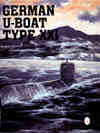German U-Boat Type XXI
Breyer, Siegfried
1999, Schiffer Military/Aviation History, Atglen
ISBN 0764307878
Paperback, 49 pages, 64 b&w photos
| Type. | Technical Data |
| Pros. | Great photography |
| Cons. | Too brief; typos |
| Rating. |  |

This slim but valuable volume provides a concise account of the development of the Type XXI U-boat. At the twilight of the war, the Kriegsmarine unleashed a new class of war-fighting submarine that differed greatly from the submersibles that hunter-killer groups were sinking with appalling alacrity. Although the circumstances that led to the neutralization of the U-boat as a war weapon and swung the Battle of the Atlantic in the Allies' favor are well documented, it is not generally known that the type XXI, or "Great Electroboat" as it was referred to, differed radically from its predecessors and was an entirely new vessel in terms of design and operational strategy.
In the face of defeat, Dönitz promised to build a bigger boat that could accommodate a larger powerplant and place a greater emphasis on underwater characteristics. The author, who witnessed the launch of the very first U-boat of this class -- U-2501 -- on May 12, 1944, notes that the new vessel's larger size, streamlined tower and "y-shaped" stern created quite a stir among those who watched them roll down the slipways at the Blohm & Voss shipyards.
Cause for excitement was not without justification. The Great Electroboats carried thrice the number of batteries, allowing an underwater speed of 17 knots (sustainable for an hour). Indeed, this new vessel could reach faster speeds below the waves than it could on the surface! Its greater size accommodated six torpedo tubes forward, and for the first time the men did not have to share their living quarters, as the eels were allotted their own compartment. The reserve torpedoes were stored in side racks, which facilitated speedy reloading of the tubes. Below the pressure-hull deck, special trolleys were installed, vastly improving the speed with which the reserve torpedoes were maneuvered from the hold. After the initial round of six torpedoes, the type XXI could fire another salvo within five to six minutes, and yet another volley twenty minutes after that. Perhaps most importantly, the "balcony listening device" with its improved range of sonic detection provided the U-boat's commander with information about the enemy derived entirely from sound impulses, and attacks could be conducted while completely submerged. The days of sighting the enemy through a periscope, exposing the vessel to attack, were over! However, although these developments made good on Dönitz's promise to build a boat that could dive deeper, travel faster and farther, and carry out its duties without risk of detection, they were realized too late.
Of particular interest is the chapter on manufacturing, which reveals how the effort to rejuvenate the U-boat arm of the Kriegsmarine was doomed from the start. The new U-boat was divided into nine sections and each section was constructed independently at one of nine shipyards, none of which was responsible for building more than four sections. Once a section was finished it was sent to one of three assembly yards. In ideal conditions, this decentralized section-building technique would have contributed to Germany's legacy of genius for manufacturing and logistics, but with air attacks becoming increasingly prevalent, this strategy worked against them. If one shipyard or transport system was disrupted by an air raid, the entire process was delayed. Not surprisingly, of the 740 vessels contracted, only 123 were put into service.
Toward the end of the war, propagandists primed the German public for the arrival of new "wonder" weapons. The Great Electroboats, so much different than anything that had come down the slipways before, were hardly miraculous, and they came too late. However, with their emphasis on undersea proficiency, these vessels were the true forerunners of the modern submarine. Tantalizing questions remain. Had they come sooner, would the type XXI have changed the outcome of the war? The author answers with an unequivocal No. He does, however, suggest that the changes to the new U-boat were substantive enough to delay the inevitable outcome, which would have had the grim result of forcing Allied strategists to consider German cities, not Japanese, as targets for Truman's own wonder weapons.
Originally published as "Marine Arsenal-wunderwaffe Elektro-Uboot Typ XXI" this soft-cover book (8.5 x 11) feels like an exceptionally thorough brochure. Moreover, the translation is poor and there are numerous typographical errors. However, it should be of particular value to historians and technophiles, for it draws from a number of untranslated sources and is augmented by charts detailing everything from building contracts to the manufacture of raw sections. Richly illustrated with beautifully detailed photographs, many of which were snapped from the shipyards at Bremen, Hamburg and Kiel, one gets a sense of the immense effort that was undertaken to give the men who went to sea in U-boats a fighting chance.
Review written by Jim Ruland.
Published on 19 Jan 2001.
Purchase information: (info) Get German U-Boat Type XXI now at amazon.co.uk (£ 13.79)
Get German U-Boat Type XXI now at amazon.co.uk (£ 13.79)
Return to our main review page.



